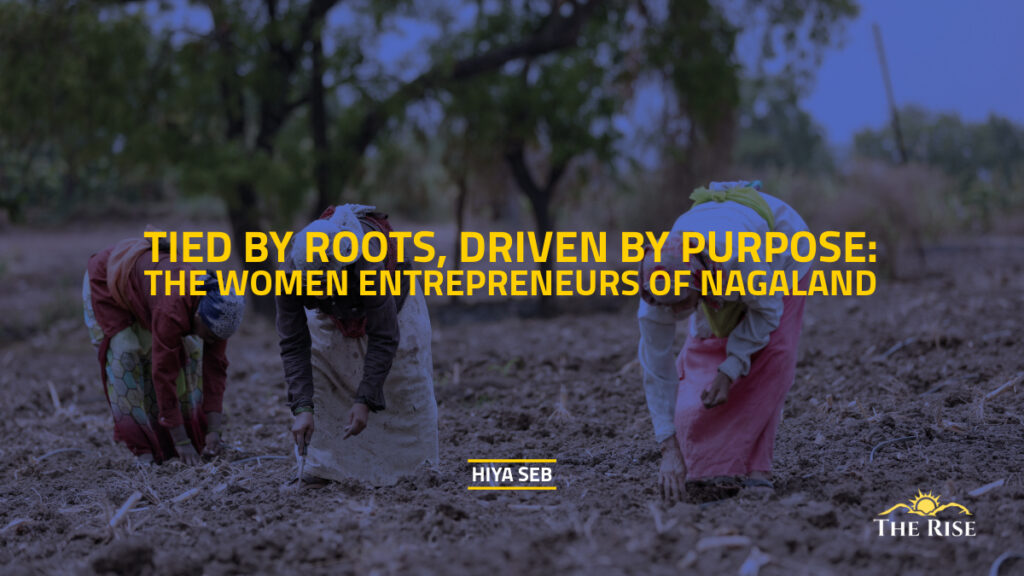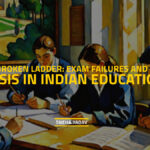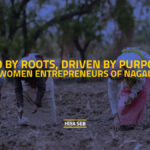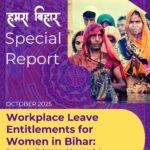Women’s empowerment through SHGs goes beyond income: it builds leadership, confidence, and voice—qualities critical for breaking deep-seated gender hierarchies in Naga society.
In the closely knit neighbourhood of High School Colony, perched on the gentle foothills of Kohima, three women gather each evening after their church fellowship. As dusk paints the sky in soft hues, they gather in a modest shared workspace, their hands moving in quiet synchrony—sharing sisterhood as intimately entwined as the roots of the local fruit trees they so cherish, bearing fruit for the honest work they invest. They are bound by a bond strengthened by a shared background: their husbands are all retired government employees, and they hail from the same ancestral village. Together, they channel these inspirations into their business devoted to local dry fruit products.
Aja’s Kitchen is a self-driven, peer-led SHG that showcases the spirit of three Rengma Naga women, Mehile, Chennu, and Khushali, all in their 50s and 60s. With modest but meaningful earnings, they have found fulfilment and a sense of purpose, highlighting the transformative power of economic agency. Born out of the hardships of the COVID-19 lockdown in 2021, Aja’s Kitchen began as a heartfelt initiative. Today, it operates as a small SHG that prepares and packages locally cherished candied fruits such as gooseberry, wild apple, and hog plum.
“We started this for our self‑consumption, gifting others, and earning a small amount to meet our needs,” says Mehile. This springs from the deeply ingrained Naga culture of hospitality—an ethos where gifting neighbours and loved ones, irrespective of the occasion, is customary. In any Naga village, it is very common for visitors to receive tokens of affection—locally grown vegetables, fruits, or preserved delicacies such as candied gooseberries. Through her business, she reimagines this same hospitality and sees herself as a custodian of this tradition. She thoughtfully sends her preserves to nieces and nephews studying outside the state.

When asked how their home-run business has impacted their lives, they responded with great humility—“It is good for us because we can earn pocket money for ourselves. We don’t get a huge profit, but we get enough.” As housewives, their words echo the quiet triumph of regaining economic agency, the joy of modest independence, and the dignity of contributing to one’s household.
The business has not yet seen formal expansion, yet the simplicity and heart behind every packet remain evident. The name “Aja,” meaning “mother” in the Rengma dialect, reflects the warmth, care, and affection poured into their products. Their candied fruits are especially popular among young Nagas studying outside the state, offering a comforting taste of home and boosting sales during the holiday season.
This report seeks to analyse the genesis, functioning, and overall significance of women-led Self-Help Groups (SHGs) and cooperatives in Nagaland with special focus on Aja’s Kitchen. It assesses the challenges encountered by these groups and outlines recommendations to enhance their sustainability within the wider lens of gender equity and inclusive economic development in Nagaland. To support the research objectives, interviews were conducted with the participants to ensure holistic insights.
The establishment of SHGs across Nagaland owes much to the Nagaland State Rural Livelihood Mission (NSRLM), operating under the National Rural Livelihood Mission (NRLM) by the Ministry of Rural Development, Government of India. This flagship initiative enables poverty alleviation and rural upliftment, championing the cause of women’s empowerment through self-organized groups, skills training, entrepreneurship, and financial inclusion. As of 31st March 2024, there are a total of 8960 cooperative societies across all districts and at all levels and niches.[1] NSRLM organises platforms like the Regional Sale of Articles of Rural Artisans Society (SARAS) Fair, under the brand Womenfolk, to showcase and market SHG-produced goods statewide and beyond. Numerous SHGs, rooted in traditional practices like organic farming and handloom artistry, have flourished— showcasing how development and cultural preservation can harmoniously coexist.
Development and Evolution of Aja’s Kitchen
Aja’s Kitchen had humble beginnings, with an initial seed investment of approximately ₹20,000–₹30,000. They started by procuring fruits at wholesale rates—specifically gooseberries, hog plums, and wild apples—sourcing these from nearby regions like Khonoma, Kithagha village under Tseminyu district, and from Mao vendors of Manipur. These fruits are purchased at roughly ₹20 per kg or ₹380 per bag.
All operations take place in a member’s kitchen, each taking turns to host the other two. The process involves boiling the fruits after cleaning them, followed by adding the sugar. The mixture is then left to sit for a few days before being sun-dried. The time-consuming part involves cutting the gooseberries and wild apples and chopping them into desired sizes, which is preceded by seed removal. All packaging is handled in-house, while labelling is outsourced to local print shops. They have also been registered with FSSAI, legitimising their business and assuring consumer safety and hygiene conditions.

Credit Accessibility & Sales
In their journey so far, the group has consciously stayed away from formal credit systems— neither taking loans nor seeking bank financing. They depend on their own savings as well as an internal savings group of women from their village. In the beginning, the group pooled ₹10,000 to make and sell products like sticky rice roti and pickles in local markets to boost their savings. However, due to time constraints, they now contribute ₹500 each, which is saved in a bank account and allowed to grow through interest. The group lends funds only to its members, either for family emergencies or as interest-free loans to support their businesses. This system acts as a financial safety net, especially during times when personal savings fall short.
In 2022-23, the members shared that they did make a commendable profit. However, this year, in 2025, they face competition from anonymous vendors who sell the same variety in small, transparent packets which are at nominal rates. These competitors, operating without food safety verifications, have impacted the group’s sales, highlighting the vulnerabilities of small, home-based enterprises in unregulated markets.

Business strategy
The trio’s approach to business has been organic and deeply rooted in the grassroots. Without formal training or external assistance, they rely on word-of-mouth marketing and sell their products at wholesale rates to local establishments, including bakeries and highway eateries like the Manipur restaurant at Botsa. Packets priced at ₹60 are sold at ₹50 each to these outlets. Transport is self-managed, often hiring taxis costing ₹600–700 per delivery. The strain of such repeated expenses and the absence of a structured business plan hinders their full potential.
Challenges
The group’s journey, while inspiring, is not without trials. Firstly, they have limited awareness of government initiatives such as benefits under the Nagaland State Rural Livelihood Mission and Pradhan Mantri Jan Dhan Yojana, which aim to promotethe financial inclusion of women. Moreover, they are reluctant to take up loans from the bank due to higher interest rates and risks ahead.
According to the Directorate of Rural Development, Nagaland, as of the year 2022–23, out of 1,561 registered women’s Self-Help Groups (SHGs) under the Nagaland State Rural Livelihood Mission (NSRLM), only 690 have accessed bank credit, accounting for less than 50% of the total.[2]
Secondly, relying on external fruit vendors for raw materials compromises their independence and increases input costs, affecting overall profitability.
Third, the absence of a formal business plan and strategic planning limits their ability to scale operations. Additionally, digital illiteracy and minimal social media presence, compounded by age-related constraints, restrict their reach to a broader audience.
In addition, they have also pointed out that, as women in their 50s and 60s, health issues related to ageing and menopause restrict their active participation in the production process, necessitating informal outsourcing of work.
Another concern is the retail limitations due to tight shelf space in stores. In a convenience store in Kohima, they pointed out that the owners were willing to buy just 2 dozen of their food packets, hampering their business reach. The lack of food security checks in the local marketplace promotes cheaper alternatives without any FSSAI approval to be sold, posing great competition to their products.
Lastly, the rising cost of transportation is becoming increasingly unaffordable, threatening the long-term sustainability of their operations.
Way Forward
There is a need to enhance awareness about the Nagaland State Rural Livelihood Mission (NSRLM) as it plays a vital role not only in funding SHGs but offering skills training, livelihood support, and mentorship opportunities. By equipping women with such tools for value addition, digital skills, and marketing knowledge, their contributions can transition from local to scalable enterprises. Moreover, its awareness programs around domestic violence, gender equity, and early marriage further strengthen the social agency of women. Further, access to a reliable formal source of credit shall serve as a powerful foundation for women’s empowerment.
To elevate outcomes for groups like Aja’s Kitchen, digital marketing is crucial. Introducing structured models, such as ‘Train-the-Trainer,’ can help build their leadership resilience. Trained Digital Ambassadors within SHGs can disseminate skills organically, ensuring continued mentorship and growth. The state government could consider offering internship opportunities to youth seeking work experience by connecting them with Self-Help Groups (SHGs). These internships could focus on enhancing marketing strategies and establishing a social media presence for SHGs.
To maximise long-term impact, periodic assessments, mentoring, and exposure to marketplaces must be institutionalised. Combining technology, grassroots leadership, and capacity building can transform women-led SHGs into engines of economic and social transformation—solidifying their place as community changemakers.
Social empowerment for women in Nagaland has always been a contested space. It is also important to connect the present context of Naga women and the Naga customary law. Prof. Lucy T.V. Zehol, currently a Professor at the Department of Anthropology, North-Eastern Hill University (NEHU), argues that gender relations in Naga patrilineal society highlight women’s economic dependence on men, in the context of the dubious “other”, “the female”, in traditional and modern Naga societal setups.[3] Although women are active in the production process, and their activities are essential for maintaining economic continuity, women, however, do not have the opportunity to accumulate such wealth. Customary law, both directly and indirectly, promotes “social inequality, hierarchical social order and missing adjective political institutions”.[4]
One can be hopeful that women’s empowerment has slowly gained ground, slowly reversing the narrative. Women’s empowerment through SHGs goes beyond income: it builds leadership, confidence, and voice—qualities critical for breaking deep-seated gender hierarchies in Naga society.
(Edited by Sneha Yadav)
(Hiya Seb is an intern with TheRise.co.in)
[1] Directorate of Economics and Statistics, Government of Nagaland, Nagaland Statistical Handbook 2024, Kohima, 2024
[2] Directorate of Economics and Statistics, Government of Nagaland, Gender Statistics Nagaland 2024, Kohima: N.V. Press, 2024
[3] Zehol, Lucy, Women in Naga Society, New Delhi: Regency Publications, 1998
[4] Longkoi, Khiamniungan T., ‘Is Naga Society Egalitarian and Democratic? The Gender Questions on Customary Law and Its Practices in Nagaland’, History and Sociology of South Asia, Vol. 18, Issue 1, 2023, pp. 23-37


































































Pingback: Growth and A Reckoning by David Susskind - TheRise.co.in
Pingback: Women Cab Drivers and Urban Mobility - TheRise.co.in